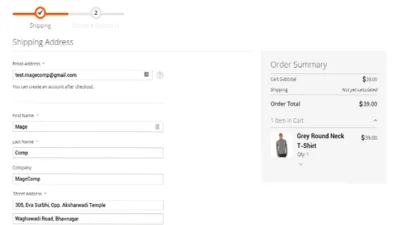Magento is the leader in ecommerce development and there are enough reasons and statistics to justify the same. From Coca Cola to Nestle, it has powered thousands of web stores globally and the numbers are increasing with time.
After reading this blog, you will understand the main reasons behind the popularity of Magento in the ecommerce development industry. Before exploring them, let me tell you some interesting statistics about this Adobe-powered platform –
- Magento powers 1% of the internet. (Source: W3Techs)
- Magento has a 1.9% share of the CMS market. (Source: W3Techs)
- More than 250,000 merchants worldwide use Magento as their e-commerce platform. (Source: Magento IT Solutions, Magento.com)
- The number of Magento sites has nearly doubled between March 2017 and August 2018. (Source: Build With)
- 202 Magento users are on the Internet Retailer Top 1000 list. (Source: Magento.com)
- Magento has held the #1 spot on the Internet Retailer 1000 list for four years in a row. (Source: Magento.com)
- Magento handles over $155 billion in transactions every year. (Source: Magento.com)
- The number of online shoppers served by Magento merchants is expected to increase by 200% between 2016 and 2020. (Source: Creative Minds)
10 Reasons behind Magento’s Popularity:
1. Open Source:
Yes, it is free and will always be so!
Magento was released under the Open Source License version 3.0 and built using PHP and other open source tools. The open source framework gives Magento many distinct advantages over other platforms. It is flexible and can be modified endlessly to suit project requirements. Moreover, open source tools are well-known for their robust performance and provide enhanced security to merchants and developers.
2. The Magento Community:
Magento is backed by a global community of ecommerce experts who are willing to help every business owner in the best possible manner. The community broadly consists of –
- 360,000 forum members
- 8,000 certified developers
- 5,900 contributors
- 1,150 independent partners
Other members include store owners, merchants, designers, agencies, ecommerce consultants, tech solutions providers, and general end users. The community ensures that the platform remains up-to-date, fast, reliable, secure and free from bugs. The members also make sure that every newcomer feels at home while building his or her roadmap to success.
3. Customizable security:
There is a lot of volatility and uncertainty involved in online transactions and data handling. The incidences of hacks and other cyber-crimes are also increasing day by day. In such a scenario, it becomes important to opt for a secured technology platform.
Magento provides end-to-end security and covers every aspect of security, ranging from PCI compliance, role-based authentication, SSL security to Multi-level Source Validation and much more. It also releases security patches and detailed vulnerability reports on a regular basis. Leading Magento Development Company regularly upgrade their systems with these patches to keep the ball rolling for the ecommerce giants.
4. No Restrictions on Hosting:
Shopify and Volusion (the “made for ecommerce” platforms) don’t offer the flexibility to host on external servers. However, Magento allows you to choose the hosting solution of your choice while prioritizing your requirements and budget. Similarly, if you want to migrate your store to a new hosting solution, you can do it without any hesitation.
5. Third Party Components Integration:
Third party plugins simplify the routine tasks of Magento store administrators and developers. Magento users can integrate an unlimited number of third party components with their stores to shorten the development and deployment timeframes.
With the help of extensible API in Magento, you can connect to any external application or plugin seamlessly. It could be a payment gateway, an analytics tool or shipping and tracking method. You need to make sure, however, that the authenticity of the 3rd-party vendor is verified before installation or integration.
6. Default Responsive Design:
The share of smartphones in global ecommerce transactions is rising steadily to surpass other types of devices. Magento incorporates HTML5 capabilities to ensure that the storefront has a responsive design to cater to mobile devices. In addition, you will find features such as griding, image scaling, AV (audiovisual) capabilities, gesture controls, drag-and-drop, etc. in Magento interface.
7. Fast & Scalable:
Let’s take a look at some facts and figures before discussing this point –
- Page abandonment rates increase most steeply between one and four seconds.
- Mobile users expect pages to be loaded just as quickly on their smartphones as they do on their desktops.
- 79% of shoppers, according to the noteworthy Gomez and Akamai studies, will avoid shopping again at a site where they had poor experience or that was too slow
- Conversion rates can improve by as much as 10% for every second of speed improvement.
(Source: Magento Blog)
Magento is a winner when it comes to loading web pages quickly. It uses high-end caching technologies such as Cloud ways Full Page Cache and other database optimization techniques like Memcached and Redis to speed up the stores considerably.
The scalability of Magento is unmatched and it is suitable for every type of business. It is composed of a modern architecture built using popular frameworks and coding patterns that helps you to meet virtually any business need with speed and agility. Magento 2.0’s modular design reduces application complexity and enables you to easily extend or customize core functionality with off-the-shelf extensions or your own code to ensure a faster time to market.
8. Magento Extensions & Customization Options:
The design conventions of ecommerce stores are different for every industry. The size and scale of operations, customer support requirements, billing and delivery options, etc. pose various challenges in the ecommerce environment.
Magento is a highly customizable ecommerce platform. You can design incredible front-end user experiences by editing layouts and templates or adding new colors and styles. The backend can also be redesigned by rewriting code, modifying events and grids.
One of the key points of interest for all Magento users is the vast Magento marketplace of over 4000 extensions and modules. Users can explore and integrate multiple extensions with a few clicks. Every extension in the marketplace is checked for plagiarism, coding standards, compatibility, and security. Besides, you can also buy custom extensions from Magento web development companies.
9. Multi-Store Environment:
Most ecommerce platforms in the market offer the privilege of a single store per account. With Magento, you can set up multiple stores and manage them through a single backend. The stores’ inventory, orders, billing, and customer information can be controlled easily by the backend users.
Different themes and templates can be customized for every store in your account. You can also assign a subdomain for individual stores and will never face any difficulty in their management and administration.
10. SEO-friendly:
Building an online store will do you no good if it cannot rank well on Google or other search engines. Search engine visibility drives traffic to your website and leads to conversions. So, you cannot ignore search engine optimization (SEO) when it comes to ecommerce website development.
Magento is an SEO-friendly platform and helps you in optimizing your web pages for better rankings. You can measure the traffic on your page, check the content for plagiarism, apply proper Meta tags and generate site-maps.
Summing it up
Magento is a one-of-its-kind ecommerce solution that is loaded with enterprise power, unlimited scalability, and open-source flexibility. It is a tool to create unique, full-lifecycle customer experiences that can generate more sales. You can choose any type of business model for development – Omni channel, global expansion, mobile – and Magento will write the success story for your business.












